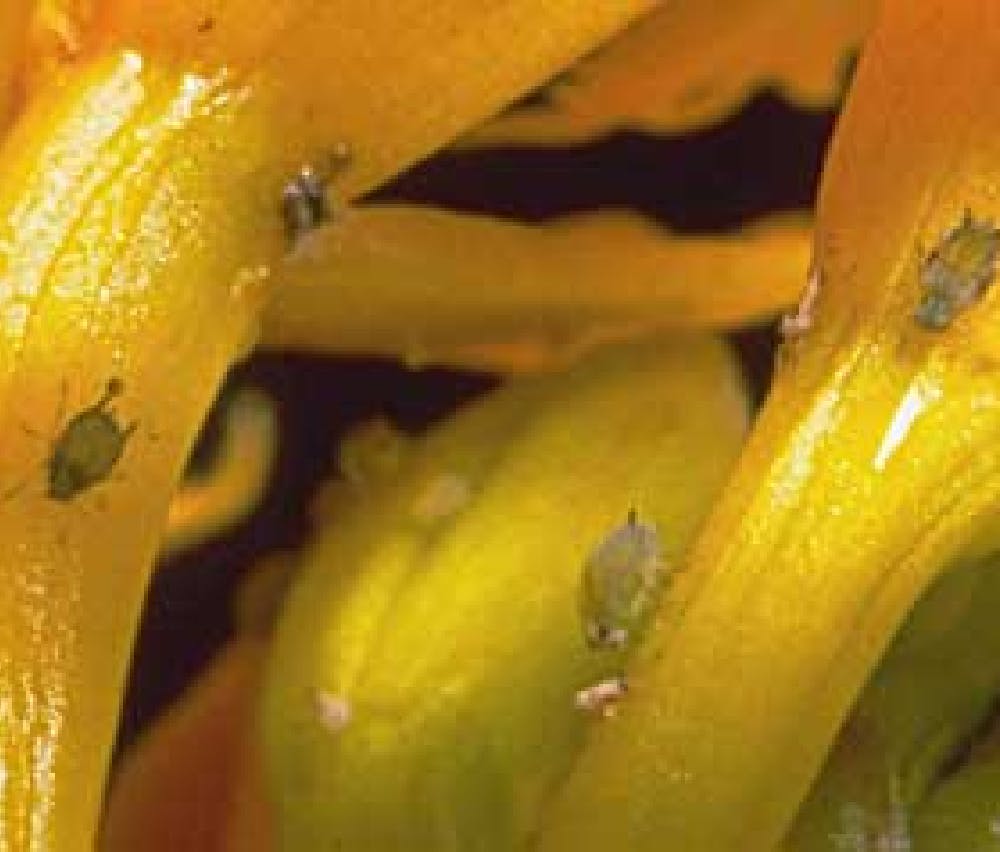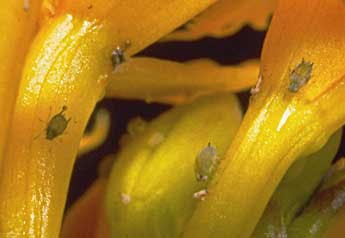
Aphids


Gallery

Symptoms
These insects are easy to spot. Their rapid reproduction and development quickly produces colonies, which feed on the parts of the plant receiving the most nutrients. They can be found on new growth, at the base of buds, on flowers and on the undersides of leaves. Their feeding causes poor growth, stunted plants or curled and distorted leaves. Developing aphids shed white skins. A pile of them on upper leaf surfaces may be your first sign that these destructive insects have arrived.
Additional Information
Most are wingless, but winged versions appear to migrate between plants when a colony becomes crowded.
Further Reading
Barkalow, Ray. Insect Pests: Aphids. Web article from First Rays Orchids, Doylestown, Pennsylvania.
Hamon, Phd., Avas B. 1995. Orchid Pests. In Orchid Pests and Diseases. American Orchid Society, West Palm Beach. Page 43.
Kultana Orchids. Orchid Diseases and Pests: Aphids. Web article from Kultana Orchids, Bangkok, Thailand.
Macara Orchids. What Pest Is That? APHIDS. Web article from Macara Orchids, Masterton, New Zealand.
Mersino, Ed. Ask the Experts Database: Dendrobiums. Web article from the College of Tropical Agriculture and Human Resources, University of Hawaii at Manoa.
Wright, Jane. 1994. Orchid Pests and Diseases. Web article from book Growing Orchids in Canberra. P. 56.
Susan Jones was the editor of Awards Quarterly and assistant editor of Orchids. American Orchid Society, 16700 AOS Lane, Delray Beach, Florida 33446
All reuse must contain the follwing:
Reprinted from the OCTOBER 2001 issue of Orchids -- The Bulletin of the American Orchid Society. Copyright American Orchid Society -- www.aos.org
Life Cycle
The adult female aphid gives birth to between 60 and 100 female nymphs every day for a period of 20 to 30 days. These nymphs immediately start to feed and grow, molting several times to mature to an adult female capable of reproducing within seven to ten days, all without maturing. Within a few days, thousands of aphids can be born.
When colonies become overcrowded, winged forms appear, to fly to establish new colonies. The insects can cycle continuously under greenhouse conditions, their rate of development affected only by temperature.
In the autumn, females begin producing a few males. Females born at the same time have eggs within their bodies; they mate and lay the eggs to provide next season's offspring.
Damage
Where buds are attacked, the flower - if it opens at all - will be mottled and distorted. The sap sucking may result in wilting, deformed plant growth, yellowing, and even loss of leaves. Aphids' salivary secretions can also be toxic to their host plant.
Aphids eat more plant fluids than they can digest, excreting honeydew - a sweet, syrupy material - on leaves and stems. This attracts sooty mould, a fungus that grows in honeydew, making leaves look dirty and black. Ants are also drawn to honeydew; they feed on it, and will fiercely defend their source against predators. They will even farm aphids, moving them from plant to plant so that additional honeydew factories can be created. Traveling between plants, aphids can introduce and spread virus and disease.
Control
Prevention is better than a cure; good cultural practices and purchasing healthy plants reduce the chance of infestation. The most common way of acquiring pests is buying an infested plant. Aphids easily colonize clean plants when they are grown close together, allowing movement from plant to plant. Winged aphids may colonize orchids that are outdoors, or indoors and in greenhouses where air currents from fans help spread the critters. To control the proliferation of aphids, immediately isolate an infested plant.
Fortunately, aphids are not difficult to eradicate. For any treatment method, repeat the procedure twice after the initial application at seven- to 10-day intervals to kill successive generations. Test any treatment on a small population of plants before widespread use.
To control aphids, one must also eliminate ants. Insecticides destroy the worker ants that move and protect aphids, but the colony must be eradicated for total control. Sugar-based ant baits are recommended, as ants that farm aphids prefer sugar over fats.

FREE ACCESS: Orchid DealWire
Get notified when orchid vendors have special promotions and exclusive savings.








